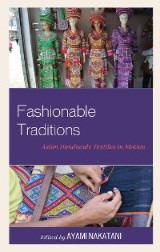Details

Fashionable Traditions
Asian Handmade Textiles in Motion|
42,99 € |
|
| Verlag: | Lexington Books |
| Format: | EPUB |
| Veröffentl.: | 28.01.2020 |
| ISBN/EAN: | 9781498586504 |
| Sprache: | englisch |
| Anzahl Seiten: | 316 |
DRM-geschütztes eBook, Sie benötigen z.B. Adobe Digital Editions und eine Adobe ID zum Lesen.
Beschreibungen
<span>Textiles play a decisive role in history: attire not only indicates status, gender, ethnicity, and religion but illustrates how such boundaries are continuously being negotiated, shifted, and recreated. </span>
<span>Fashionable Traditions</span>
<span> captures the complex reality of Asian handmade textile production and consumption. From traditionalist discourse and cultural authenticity to fashion and market trends, the contributors to this collection demonstrate the multilayered influence of often contradictory forces. In-depth, ethnographic case studies reveal the entangled relationships between local artisans, external interventions, and consumers, while acknowledging the broader frameworks in which such relationships are situated. Together these stories offer a vivid account of the socio-economic, political, and cultural dynamics in various parts of Asia and emphasize that fashion is neither a Western prerogative nor do its roots reside solely in the West.</span>
<span>Fashionable Traditions</span>
<span> captures the complex reality of Asian handmade textile production and consumption. From traditionalist discourse and cultural authenticity to fashion and market trends, the contributors to this collection demonstrate the multilayered influence of often contradictory forces. In-depth, ethnographic case studies reveal the entangled relationships between local artisans, external interventions, and consumers, while acknowledging the broader frameworks in which such relationships are situated. Together these stories offer a vivid account of the socio-economic, political, and cultural dynamics in various parts of Asia and emphasize that fashion is neither a Western prerogative nor do its roots reside solely in the West.</span>
<span>Fashionable Traditions</span>
<span> captures the complex reality of Asian, handmade textile production and consumption. Contributors to this collection reveal the entangled relationships between local artisans, external interventions, and consumers to offer a vivid account of the socio-economic, political, and cultural dynamics of Asian fashion.</span>
<span> captures the complex reality of Asian, handmade textile production and consumption. Contributors to this collection reveal the entangled relationships between local artisans, external interventions, and consumers to offer a vivid account of the socio-economic, political, and cultural dynamics of Asian fashion.</span>
<span>List of Figures and Tables</span>
<br>
<br>
<span>Preface</span>
<br>
<br>
<span>Introduction: Asian Handmade Textiles as Fashionable Traditions</span>
<br>
<br>
<span>Ayami Nakatani</span>
<br>
<br>
<br>
<br>
<span>Part 1: Fashion Dynamics in Tradition</span>
<br>
<br>
<span>Chapter 1</span>
<br>
<br>
<span>Ikat Patterns in Flores, Indonesia, and the Global Fashion Trajectory</span>
<br>
<br>
<span>Willemijn de Jong</span>
<br>
<br>
<span>Chapter 2</span>
<br>
<br>
<span>“New Style” of Ethnic Clothing: Dress between Tradition and Fashion among the Hmong in Yunnan, China</span>
<br>
<br>
<span>Chie Miyawaki</span>
<br>
<br>
<p><span>Chapter 3</span><br><br><span>The Pashmina Shawl: Continuity and Transformation from Ladakh to Kashmir</span><br><br><span>Monisha Ahmed</span><br><br><br><br><span>Part 2: Politics of Heritage and Beyond</span><br><br><span>Chapter 4</span><br><br><span>Listing Cultures: Politics of Boundaries and Heritagization of Handwoven Textiles in Indonesia</span><br><br><span>Ayami Nakatani</span><br><br><span>Chapter 5</span><br><br><span>Between Culture and Technology: “Theme” Saris and the Graphic Representation of Heritage in Tamil Nadu, India</span><br><br><span>Aarti Kawlra</span><br><br><span>Chapter 6</span><br><br><span>“Heritagization” as a Double-edged Sword: The Dilemma of Nishijin Silk Weaving in Kyoto, Japan</span><br><br><span>Okpyo Moon</span><br><br><span>Chapter 7</span><br><br><span>Inheriting Weaving Knowledge in Depopulated Communities: Conservation of Wisteria Fiber Textiles in Kyoto, Japan</span><br><br><span>Miwa Kanetani</span><br><br><br><br><span>Part 3: Contested Valorization and the Role of Mediators</span><br><br><span>Chapter 8</span><br><br><span>Branding Tsumugi Kimono in Japan: Kimono Magazines as Mediators between Consumers and the “Mingei” Movement</span><br><br><span>Seiko Sugimoto</span><br><br><span>Chapter 9</span><br><br><span>“Crafts” to “Art”: A Trajectory of Aboriginal Women’s Weavings in Arnhem Land, Australia</span><br><br><span>Sachiko Kubota</span><br><br><span>Chapter 10</span><br><br><span>Translocal Ikat in Contemporary Bali, Indonesia: Imagining Heritage, Imagining Modernities in Ikat Production and Marketing</span><br><br><span>Susan Rodgers</span><br><br><br><br><span>Part 4: Ambivalent Encounters with Global Consumers</span><br><br><span>Chapter 11</span><br><br><span>Embroidering Development: The Mutwa and Rann Utsav in Kutch, India</span><br><br><span>Michele A. Hardy</span><br><br><span>Chapter 12</span><br><br><span>Strategic Choices of Techniques: Dyed and Printed Textiles for Goddess Rituals in Gujarat, Western India</span><br><br><span>Yoko Ueba</span><br><br><span>Chapter 13 </span><br><br><span>Patchworking in Tradition: The Trends of Fashionable Carpets from Turkey</span><br><br><span>Ulara Tamura</span><br><br><span>Chapter 14</span><br><br><span>What Do Handwoven Textiles Do? Constellation of Things and the Primal History among Non-Weaving People in Flores, Eastern Indonesia</span><br><br><span>Eriko Aoki</span><br><br><span> </span><br><br><span>Index</span><br><br><span>About the Contributors</span></p>
<br>
<br>
<span>Preface</span>
<br>
<br>
<span>Introduction: Asian Handmade Textiles as Fashionable Traditions</span>
<br>
<br>
<span>Ayami Nakatani</span>
<br>
<br>
<br>
<br>
<span>Part 1: Fashion Dynamics in Tradition</span>
<br>
<br>
<span>Chapter 1</span>
<br>
<br>
<span>Ikat Patterns in Flores, Indonesia, and the Global Fashion Trajectory</span>
<br>
<br>
<span>Willemijn de Jong</span>
<br>
<br>
<span>Chapter 2</span>
<br>
<br>
<span>“New Style” of Ethnic Clothing: Dress between Tradition and Fashion among the Hmong in Yunnan, China</span>
<br>
<br>
<span>Chie Miyawaki</span>
<br>
<br>
<p><span>Chapter 3</span><br><br><span>The Pashmina Shawl: Continuity and Transformation from Ladakh to Kashmir</span><br><br><span>Monisha Ahmed</span><br><br><br><br><span>Part 2: Politics of Heritage and Beyond</span><br><br><span>Chapter 4</span><br><br><span>Listing Cultures: Politics of Boundaries and Heritagization of Handwoven Textiles in Indonesia</span><br><br><span>Ayami Nakatani</span><br><br><span>Chapter 5</span><br><br><span>Between Culture and Technology: “Theme” Saris and the Graphic Representation of Heritage in Tamil Nadu, India</span><br><br><span>Aarti Kawlra</span><br><br><span>Chapter 6</span><br><br><span>“Heritagization” as a Double-edged Sword: The Dilemma of Nishijin Silk Weaving in Kyoto, Japan</span><br><br><span>Okpyo Moon</span><br><br><span>Chapter 7</span><br><br><span>Inheriting Weaving Knowledge in Depopulated Communities: Conservation of Wisteria Fiber Textiles in Kyoto, Japan</span><br><br><span>Miwa Kanetani</span><br><br><br><br><span>Part 3: Contested Valorization and the Role of Mediators</span><br><br><span>Chapter 8</span><br><br><span>Branding Tsumugi Kimono in Japan: Kimono Magazines as Mediators between Consumers and the “Mingei” Movement</span><br><br><span>Seiko Sugimoto</span><br><br><span>Chapter 9</span><br><br><span>“Crafts” to “Art”: A Trajectory of Aboriginal Women’s Weavings in Arnhem Land, Australia</span><br><br><span>Sachiko Kubota</span><br><br><span>Chapter 10</span><br><br><span>Translocal Ikat in Contemporary Bali, Indonesia: Imagining Heritage, Imagining Modernities in Ikat Production and Marketing</span><br><br><span>Susan Rodgers</span><br><br><br><br><span>Part 4: Ambivalent Encounters with Global Consumers</span><br><br><span>Chapter 11</span><br><br><span>Embroidering Development: The Mutwa and Rann Utsav in Kutch, India</span><br><br><span>Michele A. Hardy</span><br><br><span>Chapter 12</span><br><br><span>Strategic Choices of Techniques: Dyed and Printed Textiles for Goddess Rituals in Gujarat, Western India</span><br><br><span>Yoko Ueba</span><br><br><span>Chapter 13 </span><br><br><span>Patchworking in Tradition: The Trends of Fashionable Carpets from Turkey</span><br><br><span>Ulara Tamura</span><br><br><span>Chapter 14</span><br><br><span>What Do Handwoven Textiles Do? Constellation of Things and the Primal History among Non-Weaving People in Flores, Eastern Indonesia</span><br><br><span>Eriko Aoki</span><br><br><span> </span><br><br><span>Index</span><br><br><span>About the Contributors</span></p>
<span>Ayami Nakatani </span>
<span>is professor of cultural anthropology and director of the Discovery Program for Global Learners at Okayama University.</span>
<span>is professor of cultural anthropology and director of the Discovery Program for Global Learners at Okayama University.</span>


















